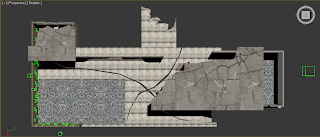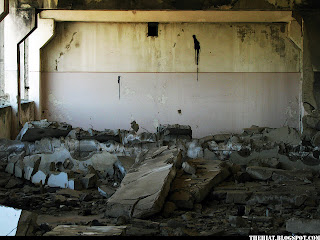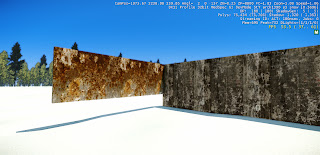The Barcelona Pavilion
SUBMISSION REQUIREMENTS
1 X STRATEGY STATEMENT
The aim for this second assignment was to interpret what would happen 100 years into the future if humans were not around. We were free to let our imaginations run wild in selecting a disaster that would essential remove human life from our environment. I decided to go with two specific ones. These would help to unveil my sources of decay in the building.
My two disasters that would bring about the demise of human civilization was an Earthquake and a zombie apocalypse. As can be seen by the corroded concrete and the jagged edges of its material, the Barcelona Pavilion had survived a disaster but in quite a bad state. The glass is shattered in places, walls are missing pieces and there are rifts in the flooring of the structure. All these point to the fact that there was a violent event which tore the pavilion apart, which was an earthquake.
The second disaster which led to the demise of the human civilization 100 years into the future was a zombie apocalypse. It would provide a good reason as to why human civilization had ceased to exist as now only pockets of resistance are left to fight the zombie hoard. It also gave me a brilliant way to bring an interactive element to my pavilion as well as a reason as to why the building could be searched. I created a breakable wall that would fall apart if a vehicle was driven into it. This would provide an interactive element as well as a thrilling scene in which a human is escaping the clutches of the zombie hoard only to loose control and end up in the pavilion.
The exploration of the pavilion would uncover scenes of decay such as trees, moss and plants all growing within and through its materials and objects such as the concrete flooring and roofing. It would also uncover signs of human habitation such as garbage bins, worn out posters, blood marks and furniture such as a bed.
My two disasters that would bring about the demise of human civilization was an Earthquake and a zombie apocalypse. As can be seen by the corroded concrete and the jagged edges of its material, the Barcelona Pavilion had survived a disaster but in quite a bad state. The glass is shattered in places, walls are missing pieces and there are rifts in the flooring of the structure. All these point to the fact that there was a violent event which tore the pavilion apart, which was an earthquake.
The second disaster which led to the demise of the human civilization 100 years into the future was a zombie apocalypse. It would provide a good reason as to why human civilization had ceased to exist as now only pockets of resistance are left to fight the zombie hoard. It also gave me a brilliant way to bring an interactive element to my pavilion as well as a reason as to why the building could be searched. I created a breakable wall that would fall apart if a vehicle was driven into it. This would provide an interactive element as well as a thrilling scene in which a human is escaping the clutches of the zombie hoard only to loose control and end up in the pavilion.
The exploration of the pavilion would uncover scenes of decay such as trees, moss and plants all growing within and through its materials and objects such as the concrete flooring and roofing. It would also uncover signs of human habitation such as garbage bins, worn out posters, blood marks and furniture such as a bed.
As a result these disasters would take an effect on the pristine nature of the Barcelona Pavilion after 100 years of non human existence within it. The pavilion has fallen apart and the overgrowth of nature has become apparent.












.jpg)




























